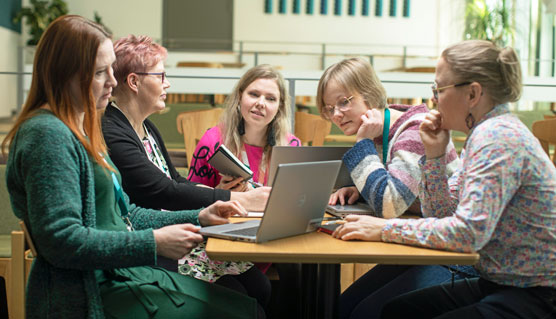
© Syke / Kai Widell
In 2022, the Finnish Environment Institute (Syke) published its second responsibility report on the impact of its operations on the UN’s Sustainable Development Goals. The report also describes the Finnish Environment Institute’s responsibility management and social responsibility as well as carbon footprint using a new, more comprehensive calculation method.
The mission of the Finnish Environment Institute (Syke) is to help build a sustainable society through research, information and services and to promote a sustainability transition.
“The Finnish Environment Institute is an international research and development organisation operating in the environmental sector. Our mission is to produce information that promotes sustainable development globally and to monitor and assess sustainability. The scope of our operations may be hard to perceive. There are no separate boxes for systemic changes in the UN’s Sustainable Development Goals (SDGs). We produce indicators, instructions, information and views for societal actors to point the direction towards more sustainable activities. Sustainability is founded on research evidence”, explains Leif Schulman, Director General of the Finnish Environment Institute.
In addition to the UN’s Sustainable Development Goals selected by the Finnish Environment Institute’s Management Group in 2021, the report discusses the various areas of Syke’s social responsibility and carbon footprint.
The responsibility report is underpinned by the State Treasury’s guidelines, which recommend reporting on responsibility through the positive and negative impacts of the organisation’s operations. The positive impact is described in terms of the so-called handprint on the UN’s SDGs, whereas the negative impact is, among other things, described as the carbon footprint of the operations.
Finnish Environment Institute’s handprint – working for a sustainability transition
The Finnish Environment Institute promotes the building of a sustainable society through research and information. Syke reports on its handprint with reference to five of the UN’s Sustainable Development Goals:
- Climate actions (SDG 13)
- Life on land (SDG 15)
- Life below water (SDG 14)
- Responsible consumption and production (SDG 12)
- Clean water and sanitation (SDG 6)
The Finnish Environment Institute plays a significant role in Finland’s journey towards carbon neutrality. In 2022, Syke continued the work of the HINKU network of municipalities aiming for carbon neutrality, calculated for the first time the consumption-based greenhouse gas emissions of all municipalities and counties in Finland, and actively participated in upgrading the Climateguide.fi portal.
Regarding Life on land, Syke is a key producer and processor of nature information for decision-makers’ needs. Among other things, Syke continued collating research evidence to promote the achievement of the European Union’s conservation goals and to support the update of Finland’s Biodiversity strategy as well as worked on providing up-to-date and comprehensive nature information that meets the different needs of society.
In the goal of Life below water, Syke had a particular focus on improving the status of the Baltic Sea, for example by producing new information and proposing solutions that would reduce its phosphorus loading.
The goal of Responsible consumption is also central for Syke, as promoting sustainable modes of production and consumption is at the core of its operations. Syke produces reliable information on sustainable production methods and consumer choices for policy-makers, consumers, companies and municipalities, enabling them to significantly reduce their use of non-renewable natural resources, emissions and waste volumes.
The goal of Clean water and sanitation is visible in Syke’s operations especially in efforts to monitor the volume and status of waters as well as to develop solutions for using, managing and protecting the water resources. Syke’s goal is increasing the proportion of bodies of water with good ecological status from their 2018 level.
Syke’s carbon footprint – new calculation method highlights the carbon footprint of procurements
The Finnish Environment Institute has engaged in sustained research and development efforts relating to different methods of ecological footprint calculations for the needs of different actors in society. It has also used the carbon footprint calculator to determine its own footprint, or the greenhouse gas emissions generated through its operations, as accurately as possible. In the current report, the footprint calculation for the first time includes the indirect carbon footprint generated through Syke’s procurements. This is why the figure describing the footprint is now significantly higher than in last year's report. The calculation method is also being developed further: many sectors are constantly reducing their emissions, which is why the accuracy of the model is improved by using the most recent data.
Our carbon footprint was 6,700 tons of carbon dioxide equivalent (tCO2-eq) in 2021 and 8,200 tons in 2022.
Syke’s carbon footprint mainly comes from procurements, operation of the research vessel Aranda, business travel, and the heat and electricity consumption of facilities. Procurements account for clearly the largest share of these categories. While the footprint generated by procurements largely depends on the supply developing towards a more carbon-neutral direction, Syke can also influence it by improving its procurement procedures. The result highlights the importance of examining the entire value chain of goods and services when estimating the carbon footprint and making procurements.
Read the Finnish Environment Institute’s responsibility report for 2022
Responsibility report 2022 (Storymaps.arcgis.com)
Further information
- Sanna-Riikka Saarela, Development Manager, firstname.lastname@syke.fi
- Heli Karjalainen, Service Development Director, firstname.lastname@syke.fi